Description
The Blackfin Dartfish, Ptereleotris evides, also known as Torpedo Goby, is a visually striking fish with a sleek, elongated body that resembles the shape of a torpedo. It can reach a maximum size of around 4 inches (10 centimetres). The body features deep hues of dark blue and yellow, making it an attractive addition to any aquarium.
Natural Habitat:
The Blackfin Dartfish is typically found in the shallow waters of coral reefs and lagoons. Its natural habitat consists of sandy areas with scattered coral or rock formations. These gobies prefer regions with moderate water flow and are often seen swimming in small groups near the bottom, exploring their surroundings.
Keeping Blackfin Dartfish Healthy:
Maintaining the health of Torpedo Gobies, or Blackfin Dartfish, requires providing suitable conditions in the aquarium. The care level for this species is considered moderate, and they are generally hardy when provided with proper care. Maintaining stable water parameters, including temperature, salinity, and pH levels, is crucial. It is also essential to provide ample hiding places in the form of live rock or coral structures to create a sense of security for the gobies.
Special Requirements and Feeding:
Blackfin Dartfish are carnivorous and require a varied diet to meet their nutritional needs. They primarily feed on small crustaceans, zooplankton, and other meaty foods. Offering a combination of high-quality marine pellets, frozen foods like mysis shrimp and brine shrimp, and occasional live foods will help ensure their overall health and vitality. It is important to provide multiple feedings throughout the day to meet their energetic nature and promote optimal growth.
How Many Should I Keep?
Blackfin Dartfish are social creatures and can be kept in small groups, preferably a pair or a small shoal. Keeping multiple Blackfin Dartfish in a suitable-sized aquarium, with ample space and hiding spots, allows them to display natural behaviours and interactions.
Lighting Preference:
The Blackfin Dartfish or Torpedo Goby, does not have any specific lighting preferences. However, providing a well-lit aquarium will enhance the visibility of their vibrant colours and patterns.
Suitable Tank Mates:
Blackfin Dartfish are generally peaceful and can coexist with a variety of tank mates, including other peaceful fish species, small invertebrates, and certain types of corals. It is important to avoid aggressive or territorial species that may pose a threat or intimidate the gobies.
Reproduction in the Wild
Blackfin Dartfish, like many other marine fish species, reproduce through external fertilization. In the wild, spawning usually occurs during specific seasons, triggered by environmental cues such as temperature and lunar cycles. During this time, males and females engage in intricate courtship behaviours to initiate the reproductive process.
Breeding Ptereleotris evides:
- Set up:
To breed Blackfin Dartfish in captivity, a spacious and well-maintained aquarium with suitable water parameters is required. Provide adequate hiding spots using live rock or artificial structures to mimic their natural habitat.
- Courtship/Spawning:
Breeding Blackfin Dartfish involves courtship rituals performed by males to attract females. The males display vibrant colours, extended fins, and perform impressive darting movements to impress potential mates. Once courtship is successful, the male and female rise together towards the surface, releasing eggs and sperm simultaneously in the water column.
- Rearing:
After spawning, the fertilized eggs float freely in the water until they hatch into larvae. The larvae are planktonic, and their survival greatly depends on a consistent supply of suitable food, such as copepods and other tiny organisms. Rearing the larvae can be challenging due to their specific nutritional requirements and vulnerability to fluctuations in water quality. Dedicated effort and specialized knowledge are essential to successfully rear Blackfin Dartfish fry.
Sexual Dimorphism
Sexual dimorphism in Blackfin Dartfish is minimal, with both males and females exhibiting similar physical characteristics and colouration. Distinguishing between the sexes is difficult without observing specific reproductive behaviours.
Distribution
Blackfin Dartfish, including the species Ptereleotris evides, are naturally occurring in the Indo-Pacific region, specifically in areas such as the Red Sea, the Indian Ocean, and the western Pacific Ocean. While captive-bred and line-bred strains may be available in the aquarium trade, the original wild fish originate from these regions.
Summary
The Blackfin Dartfish, scientifically known as Ptereleotris evides and also referred to as Torpedo Goby, demonstrates fascinating reproductive behaviour in the wild, involving intricate courtship rituals and external fertilization. Breeding them in captivity requires careful setup, courtship initiation, and successful rearing of the larvae. These gobies show minimal sexual dimorphism, making it challenging to distinguish between males and females based on physical characteristics. They are naturally distributed in the Indo-Pacific region, and while captive-bred strains may be available, the wild fish originate from the Red Sea, the Indian Ocean, and the western Pacific Ocean. Understanding the reproductive aspects of Torpedo Gobies enhances our appreciation for their complex life cycle and provides insights into their fascinating behaviour in the aquarium.
The Fish pictured here are representative only and the livestock you receive may vary in pattern, coloration, and shape.

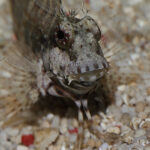
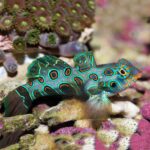


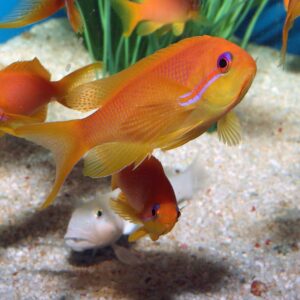

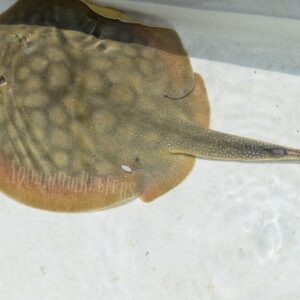

 Green Montipora Palawanensis F2
Green Montipora Palawanensis F2  Algae Free Hammerhead Float Plus
Algae Free Hammerhead Float Plus  Sera feed A plus Feeder
Sera feed A plus Feeder 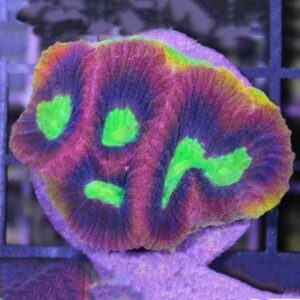 Dragon Soul Favia F5
Dragon Soul Favia F5 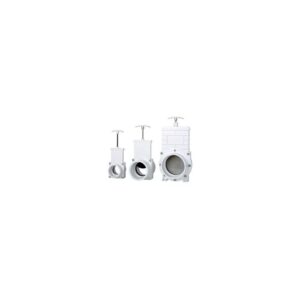 2" Knife Gate Valve
2" Knife Gate Valve  Tangerine Discosoma Mushroom F4
Tangerine Discosoma Mushroom F4
Reviews
There are no reviews yet.